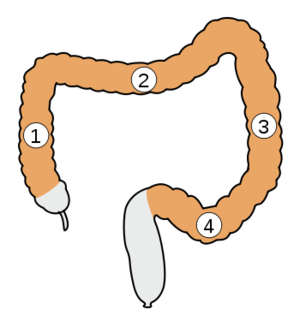A colostomy is a surgical procedure involving an opening (called a stoma) in the abdomen to allow the body to excrete fecal matter from the colon. There are several reasons why someone would require a colostomy including:
-Bowel obstruction due to cancer or impaction
-Allowing the colon to heal following a disease like diverticulitis.
-Removal of all or part of the colon, rectum, and/or anus, usually due to cancer
A colostomy can either be permanent or temporary, depending on the reason it was created. There are different types of colostomies depending on what part of the colon is being used.
Types of colostomies: Ascending colostomy
This type of colostomy is located on the right side of the abdomen in the ascending colon. The fecal matter from this type of colostomy is very liquid and contains digestive enzymes due to its location near the end of the small intestine. Because the fecal matter is very liquid, it is very difficult to control how often drainage comes out of the stoma. Odor is a problem with an ascending colostomy and can be controlled by limiting certain foods like onions, garlic, and cabbage.
Types of colostomies: Transverse colostomy
The transverse colostomy is located in the transverse colon about two inches above the umbilicus (belly button). As fecal matter moves through this part of the colon, more liquid is absorbed producing a semi-liquid, mushy drainage that is also difficult to control. Odor is quite unpleasant so try to limit foods like the ones listed above under ascending colostomy. The transverse colon is also the most likely place for what is called a loop colostomy, which has one stoma with two openings: one to drain fecal matter and the other to drain mucous..
Types of colostomies: Descending colostomy
The descending colon is on the left side of your abdomen. A colostomy in the descending colon produces a more solid fecal matter that tends to not have a strong offensive odor. Because the fecal matter is more solid, it is easier to control frequency of drainage, however there is a chance of fecal impaction. People with descending colostomies may need to massage the stoma and irrigate it with warm water to help remove fecal waste.
Types of colostomies: Sigmoid colostomy
The sigmoid colostomy is the most common type of permanent colostomy. This colostomy is located by the sigmoid colon, an “S” shaped structure at the end of the colon. Patients with sigmoid colostomies frequently have had their sigmoid colon, rectum, and anus removed due to cancer. As with the descending colostomy, the fecal matter that drains from sigmoid colostomies is quite solid and easy to control. Massaging and frequent irrigation of the stoma is required to avoid impaction.
Sources:
United Ostomy Associations of America website
LeMone, Priscilla & Burke, Karen (2008). Medical-Surgical Nursing-Critical Thinking In Client Care(4th ed.). Upper Saddle River NJ: Pearson Prentice Hall pp 803-806
Kozier, Barbara Erb,Glenora Berman, Audrey Snyder, Shirlee J (2008). Kozier and Erb’s Fundamentals of Nursing (8 th ed). Upper Saddle River NJ: Pearson Prentice Hall pp 1331-1332





